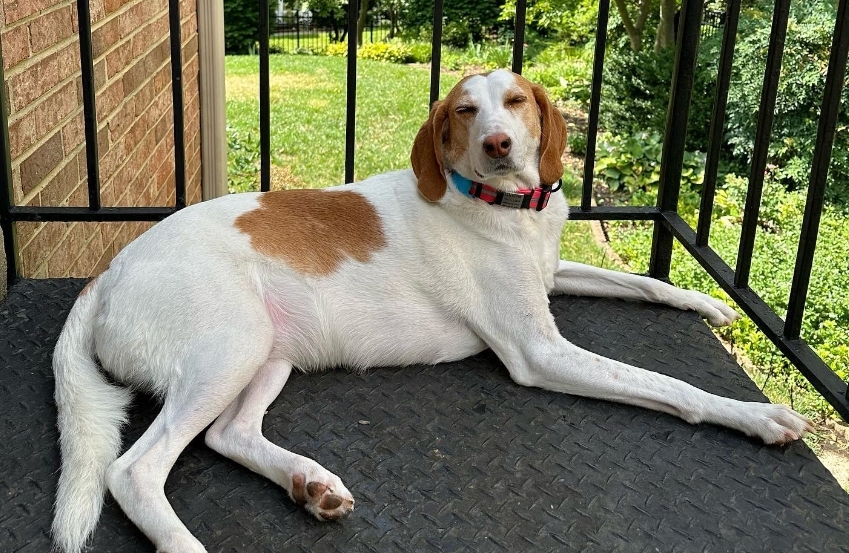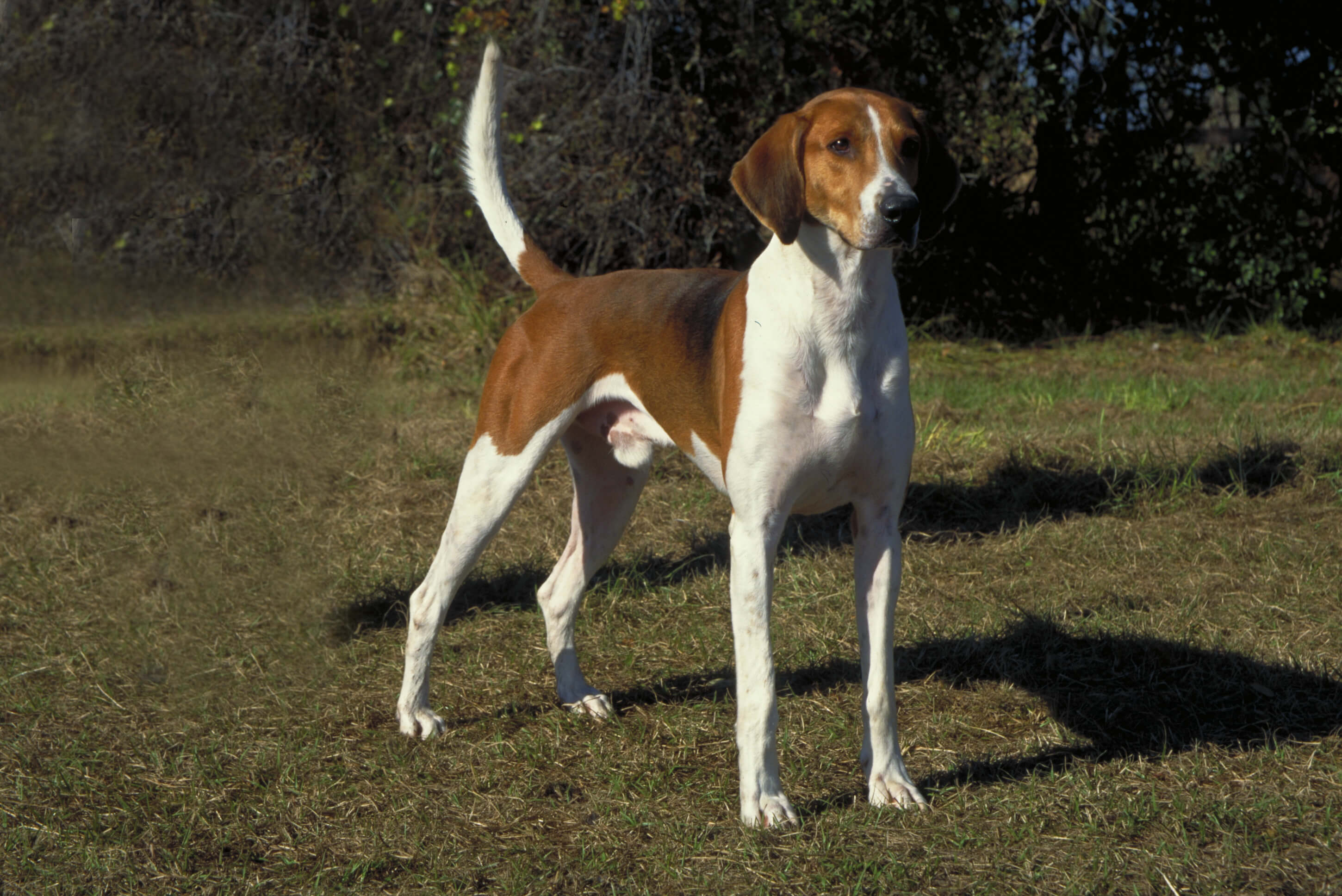Are you on the hunt for a faithful and warm-hearted companion who shares your passion for staying active and embracing the great outdoors? Look no further than the American Foxhound. This incredible breed has captured my heart over the years with its timeless charm and athletic spirit.
With their striking appearance and a love for exercise, American Foxhounds are the perfect match for individuals like me who relish outdoor adventures.
In this all-encompassing guide, I'm excited to share my deep dive into the world of the American Foxhound, including their distinctive appearance, grooming requirements, delightful temperament, training insights, and the captivating history that surrounds this remarkable breed.
Appearance of the Foxhound
Table of Contents
The Foxhound is a majestic breed that is recognized for its tall and commanding presence. A detailed look into its appearance reveals:
Height and Weight
Males of the Foxhound breed generally have a height ranging between 22-25 inches, lending them a grand posture. They also have a solid build, with their weight hovering around 65-70 pounds.
In contrast, females are slightly smaller but equally graceful, with heights spanning from 21-24 inches and weights ranging from 60-65 pounds.
Facial Features
One of the most captivating features of the Foxhound is its large, expressive eyes. These eyes, which come in shades of brown or hazel, reflect an endearing and gentle demeanor.
Adding to their unique facial appearance is their elongated head, complemented by broad ears that hang close to their cheeks, giving them a signature look.
Body & Coat
The Foxhound is not only built for elegance but also for endurance. It possesses a short, hard coat, tailored to offer protection when navigating rough terrains during hunting expeditions. This coat fits snugly on their muscular bodies and can exhibit a vast range of colors, making each Foxhound distinct in its own right.
A prominent feature of their physique is the straight and elongated front legs which give them a sturdy stance. Their tail, another distinguishing trait, often carries an upward curve, signaling alertness and enthusiasm.

Grooming Essentials
Foxhounds, with their majestic appearance, can be relatively low maintenance, but proper grooming is essential for their overall well-being and health. Here's a comprehensive guide on how to keep your Foxhound in tip-top shape:
- Bathing: Foxhounds don't require frequent baths. Only bathe your Foxhound when it becomes visibly dirty or develops an unpleasant odor. Over-bathing can strip their coat of essential oils, so use a mild, dog-specific shampoo when needed.
- Ear Care: Weekly ear checks are crucial to maintaining your Foxhound's ear health. Look for signs of wax buildup, redness, or any indications of ear infections. Always use vet-approved ear cleansers or soft cotton balls to gently clean the ears and avoid pushing debris deeper into the ear canal.
- Nail Maintenance: Monthly nail trimming is essential for Foxhounds to prevent overgrowth that can lead to discomfort and potential foot issues. Regular nail maintenance also ensures their paws remain healthy and functional.
- Dental Hygiene: Dental care is pivotal for your Foxhound's overall health. Aim to brush their teeth at least once a week, although daily brushing is ideal. Dental chews and toys designed to promote oral health can also be beneficial. Regular dental care helps prevent tartar buildup, gum disease, and bad breath.
- Health Check: Grooming sessions are an excellent opportunity to monitor your Foxhound's overall health. Keep an eye out for any signs of redness, infections, or sores on their skin, which may indicate underlying health issues. If you notice anything unusual during grooming, consult your veterinarian for further evaluation.
Understanding the Foxhound Temperament
The Foxhound, known for its striking appearance, possesses a multifaceted temperament that makes it a desirable household companion. Let's delve deeper into the nuances of their personality:
Social Butterfly
Foxhounds are true social butterflies. They have a natural affinity for companionship and readily engage with other animals. Whether it's another dog, a cat, or even a neighbor's pet, Foxhounds are known for their sociable nature, making them an excellent choice for families with multiple pets.
Active Lifestyle
These canines are born athletes. To keep them content and in peak condition, they require regular exercise. Daily walks, playtime in the yard, or even participating in dog sports like agility can help fulfill their need for physical activity. An active lifestyle not only ensures their physical well-being but also promotes mental stimulation.
Playful Nature
Foxhounds maintain their playful disposition well into adulthood. Unlike some breeds that mature quickly, Foxhounds often retain their puppy-like enthusiasm until around two years old. This youthful energy can be endearing but may require patience and consistent training to channel it positively.
Chase Instinct
Due to their hunting lineage, Foxhounds may exhibit a strong instinct to chase smaller animals, such as squirrels or rabbits.
Early socialization and obedience training are essential to manage this natural inclination. Teaching them to respond to commands reliably can help prevent potential conflicts and ensure their safety during outdoor adventures.

Training Tips and Techniques
Training a Foxhound can be immensely rewarding when undertaken with a thorough understanding of their needs and behaviors. Here are some detailed training tips and techniques to ensure success:
Phased Training Approach
Effective training often follows a structured progression:
- Teaching Phase: Begin by teaching specific commands or behaviors. Use clear, concise cues and rewards to reinforce desired actions.
- Practice Phase: Consistent repetition is key. Practice commands in various contexts and scenarios to reinforce learning.
- Generalization Phase: Gradually introduce distractions and new environments to ensure your Foxhound can perform commands in diverse situations.
- Testing Phase: Test your Foxhound's obedience in real-life situations, such as during walks or when meeting new people or animals.
- Internalization Phase: Once your Foxhound consistently follows commands, they'll internalize these behaviors as habits. Continue to reinforce good behavior periodically.
Diverse Environments
Foxhounds thrive on adaptability. Change training locations regularly to expose them to different surroundings, smells, and sounds. This helps them become more adaptable and responsive, ensuring that their obedience extends beyond just one setting.
Positive Reinforcement
Utilize positive reinforcement techniques to motivate and reward your Foxhound. Offer treats, praise, and affection when they exhibit desired behaviors. This positive association encourages them to repeat these actions. Be patient and consistent in your rewards to reinforce their training.
Consistency
Consistency is paramount in Foxhound training. Use the same commands consistently and ensure that all family members and caregivers are on the same page regarding training techniques and expectations. Regular practice sessions, even if short, are more effective than sporadic, lengthy ones.

The Rich History of the Foxhound
The history of Foxhounds is a captivating journey through time, revealing their significant role in American canine heritage:
Origins
The Foxhound's lineage dates back to approximately 1650, finding its early roots in the regions of Virginia and Maryland in the United States. It was during this period that breeders began selectively crossing various hound breeds to develop the Foxhound's distinctive traits.
Presidential Paws
Notably, one of the Founding Fathers of the United States, George Washington, was an influential figure in the early development of the Foxhound breed. He introduced French and British Foxhounds to the American breeding stock, contributing to the refinement and establishment of the breed as we know it today.
Roles Over Time
Throughout history, Foxhounds were primarily bred for fox hunting. Their remarkable tracking abilities, stamina, and agility made them indispensable in the pursuit of foxes across rugged terrains. However, as the world evolved, so did the roles of these exceptional hounds:
- Modern Competitions: Today, Foxhounds are often showcased in various trial competitions where their skills in tracking, scenting, and obedience are put to the test. These events celebrate the breed's enduring hunting heritage.
- Trail and Pack Dogs: Some Foxhounds have transitioned into trail and pack dogs, assisting hunters in tracking games such as deer and raccoons. Their enduring stamina and keen noses remain invaluable in these roles.
Tips for Adopting a Foxhound
Adopting a Foxhound is a meaningful endeavor that can bring immense joy to your life. To ensure a smooth transition for both you and your new furry companion, consider the following comprehensive tips:
- Research Extensively: Start by conducting thorough research to find shelters or rescue groups specializing in hounds, specifically Foxhounds. Look for organizations with a strong reputation for ethical and humane treatment of animals. Understanding the breed's characteristics and needs is essential to prepare yourself for the responsibilities ahead.
- Home Preparation: Before bringing your Foxhound home, make sure your living space is ready. Create a designated area for your new pet, complete with a comfortable bed, food and water dishes, and appropriate toys. Foxhounds appreciate a secure and safe environment, so pet-proof your home to prevent any potential hazards.
- Meet and Greet: Spend quality time with the Foxhound you plan to adopt before finalizing the adoption. This allows you to assess the dog's temperament and compatibility with your family and lifestyle. It's also an opportunity for your potential new companion to become familiar with you.
- Adoption Fee and Inclusions: Be prepared for adoption fees, which are common in most shelters and rescue organizations. These fees often cover essential services such as vaccinations, spaying/neutering, and sometimes even microchipping. While it may seem like an expense, it's a valuable investment in your Foxhound's health and well-being.
- Post-Adoption Patience: After bringing your Foxhound home, exercise patience as your new pet adjusts to its surroundings. Understand that the transition can be overwhelming for them, and they may need time to acclimate to their new home and routine. Provide gentle guidance, love, and consistency as they settle into their new life.

Activities to Keep Your Foxhound Engaged
Foxhounds are known for their active and inquisitive nature. To keep them physically and mentally stimulated, consider a variety of engaging activities:
Trekking and Hiking
Foxhounds have an athletic build and a natural love for the outdoors. Take advantage of their energy by going on long, adventurous treks and hikes. Explore scenic trails and let them use their keen senses to navigate the terrain. Be sure to keep them on a leash to ensure their safety.
Fetch: A classic game of fetch is an excellent way to stimulate both your Foxhound's body and mind. These dogs have a strong chasing instinct, making fetch an ideal activity. Use a durable ball or toy and engage in playful sessions that promote exercise and mental engagement. Be prepared for their enthusiasm!
Agility Training: Create an obstacle course in your backyard for agility training. Foxhounds are agile and quick learners, making them well-suited for this activity. Agility training not only provides physical exercise but also challenges their problem-solving abilities and enhances their bond with you.
Playdates: Foxhounds are social animals and benefit from interacting with other dogs. Arrange playdates with other friendly dogs in a controlled and safe environment, such as a dog park. Socialization not only keeps them happy but also helps them develop important social skills.
Puzzle Toys and Brain Games: Keep your Foxhound's mind sharp by providing puzzle toys and brain games. These toys often involve treat dispensing, requiring them to solve puzzles to access the treats. It's an excellent way to keep them engaged and mentally stimulated, particularly during indoor or rainy days.
Nose Work and Scent Games: Utilize their exceptional sense of smell with nose work and scent games. Hide treats around your home or yard and encourage them to use their nose to locate them. This taps into their natural hunting instincts and provides mental enrichment.
FAQs About American Foxhounds
1. What is the History of the American Foxhound Breed?
The American Foxhound boasts a fascinating history that dates back to the 1650s when it was meticulously developed in the regions of Virginia and Maryland. This breed has an ancestral lineage deeply rooted in various hound breeds brought to America, with significant contributions from historical figures such as George Washington.
2. What are the Typical Physical Characteristics of American Foxhounds?
American Foxhounds are renowned for their tall and imposing stature. Males usually stand between 22 to 25 inches in height and weigh approximately 65 to 70 pounds, while females tend to be slightly smaller. They possess striking expressive eyes, elongated heads, broad ears, and sport short, durable coats that display a range of colors.
3. What is the Recommended Grooming Routine for an American Foxhound?
Maintaining the grooming needs of Foxhounds is relatively straightforward. They require baths only when visibly dirty, routine ear checks and cleaning, monthly nail trimming, and attention to their dental hygiene. Grooming sessions also serve as an excellent opportunity to monitor their overall health and well-being.
4. What is the Temperament of American Foxhounds Like?
American Foxhounds are known for their sociable, active, and playful nature. They are characterized by their friendly disposition, a genuine love for companionship, and youthful energy that often continues well into adulthood. However, it's important to note that they may possess a strong instinct to chase smaller animals due to their hunting background.
5. How Can I Train an American Foxhound Effectively?
Effectively training an American Foxhound involves a phased approach encompassing teaching, practice, generalization, testing, and internalization phases. Positive reinforcement techniques, consistent training methods, and exposure to various environments are crucial for a well-rounded training experience.
6. What Are Some Activities to Keep an American Foxhound Engaged and Happy?
American Foxhounds thrive when engaged in outdoor activities such as hiking, fetch games, and agility training. Additionally, they benefit from socializing with other dogs, engaging in puzzle toys and brain games, and participating in nose work and scent games to keep them mentally and physically stimulated.
7. How Can I Responsibly Adopt an American Foxhound?
To adopt an American Foxhound responsibly, begin by researching shelters and rescue groups that specialize in hounds. Prepare your home, spend time with the dog before adoption, be prepared for adoption fees, and exercise patience during the adjustment period as your new companion settles into their new home.
8. What Is the Significance of the American Foxhound in American History?
American Foxhounds played a pivotal role in early American history, particularly in the context of fox hunting. The involvement of George Washington in their breeding contributed significantly to their development. Today, American Foxhounds continue to participate in various competitions that celebrate their rich hunting heritage.
9. Are American Foxhounds Good with Other Pets and Children?
American Foxhounds are generally sociable and can coexist well with other pets, including dogs and cats. They are also typically good with children. However, as with any dog breed, early socialization and supervision are essential to ensure positive interactions and a harmonious household.
10. What Are Some Health Considerations for American Foxhounds?
While American Foxhounds are generally healthy dogs, they can be prone to certain health issues such as hip dysplasia and ear infections. Regular veterinary check-ups, a balanced diet, and proper grooming practices are essential for maintaining their health and overall well-being.
Conclusion
Exploring the world of American Foxhounds has been a journey filled with profound appreciation for their unique qualities. These dogs, with their striking appearance and boundless spirit, have left an indelible mark on my heart.
Beyond their majestic presence and love for the outdoors, I've uncovered the layers of their history, the intricacies of their temperament, and the pure joy they bring into the lives of those fortunate enough to share their journey.
Embracing a Foxhound is a commitment that rewards patience, understanding, and a readiness to cater to their distinctive needs. Their enthusiasm for outdoor adventures and their adaptability to modern roles make them cherished companions.
With every hike, game of fetch, and moment spent together, these dogs embody the essence of companionship, leaving lasting memories and forging an unbreakable bond. My personal journey with American Foxhounds has been a testament to the enduring beauty of our connection with these remarkable animals.
Sources
https://pubmed.ncbi.nlm.nih.gov/464021/
https://www.akc.org/dog-breeds/american-foxhound/






